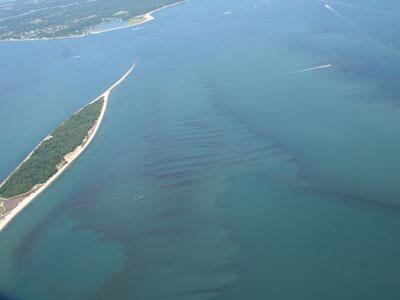Algal Tides Threaten Local Waters
Algal Tides Threaten Local Waters

The State Department of Environmental Conservation closed 490 acres of Sag Harbor Cove on April 26 to shellfishing due to detected saxitoxin, a biotoxin, in the water. The cove reopened in May, yet the incident has brought to the surface the issue of continuous water quality decline on Long Island.
Many in the field believe it vital to spread awareness of the issue now in order to find solutions before it sinks to the bottom of the public agenda. Besides restaurants and fisheries, farmers and the general public are affected by degrading water quality.
Long Island’s economy thrives on its agricultural and fishing prosperity. However, the natural quality and state of many of the island’s waterways have been unnaturally diminishing for quite some time. While summer residents and Jet Skiers come and go, water quality will remain as a continuous threat to the island’s long-term well-being.
Waterways such as Long Island’s South Shore Estuary, an integral part of the region’s economy that goes largely ignored, have been placed on the Environmental Protection Agency’s impaired-waters list. Biotoxins have spread east to Sag Harbor Cove. People may begin to question why unpleasant algal tides have begun to invade the idyllic beaches. With water quality becoming an increasing problem, recognition is an important step toward potential solutions.
Over the past 50 years, harmful algal blooms have occurred worldwide. The blooms create colorful tides, which can expand and become intrusive within marine ecosystems. The tides are then fed on by shellfish, raising the specter for consumers of paralytic shellfish poisoning, which can be fatal.
In the 1950s, green tide blooms appeared in Long Island’s South Shore bays, resulting in a decline in oyster fisheries. In 1985, brown tides were recorded in Shinnecock Bay, Great South Bay, and the Peconic Estuary. In the past decade, the scope of red and brown tides has increased. The State lists multiple sources of excessive, and therefore harmful, nutrients, such as nitrogen and phosphorus, including stormwater runoff, urban runoff, agricultural activities, and onsite septic systems. Recent reports by the Nature Conservancy and the Peconic Baykeeper point to commercial and residential septic runoff into groundwater as the primary source of excessive nitrogen, which enable algal tides.
The baykeeper, Kevin McAllister, agrees, and pointed to the E.P.A.’s report of high nitrogen levels in New York water as the primary cause of damaging algae. “Seventy-five to 80 percent of people have septic systems in their backyards, which all release nitrogen into the groundwater,” he said. “The entire East End contributes. Wherever you live in Suffolk County within a mile of a local pond or creek or bay, it’s probably on that [impaired waters] list of some form of excessive pollution.”
For the East End, with its communities dependent on a vital marine life, diminished water quality can have a financial backlash. “Our waters are becoming more and more polluted on Long Island, leading to health risks and economic hardships,” said Marci Bortman, director of conservation programs for the Nature Conservancy.
What can be done about the high levels of nitrogen? For residents, complex filtration systems for septic systems can be costly, though effective. New York State has slowly begun to consider implementing a higher standard for water quality. A new standard could see tax dollars go toward improved filtration options, such as a revamped, state-run sewage plant and additional tests on waters for both preventative and necessary measures.
Today, the nutrient level in New York water is held to a “narrative” water-quality standard, as opposed to a “numerical” one. While some observers, such as Mr. McAllister, have said that narrative standards can be “ambiguous,” the Conservancy finds complications in adopting a full numerical standard; for example, the need for some nutrients in waterways, and the immense scale of nutrients in the environment that make precise measurements difficult.
Yet Mr. McAllister and many others have urged intensified numerical reports for specific sites, which have led to closures such as was seen here in Sag Harbor Cove in April. In a sink-or-swim issue, these tides pose a real threat to the future of Long Island’s marine life and economic prosperity.
